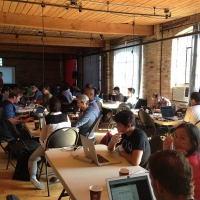Office Space: What Arrangement Is Right for Your Workplace?

The cubicle is a cliché of what is wrong with the modern office. Even if your office has a different configuration—be it open space, some configuration of offices, or a mix—it is likely that not everyone will be happy. While it's tempting to just shrug off these discussions, thinking about office layout is important for a number of reasons.
Office space affects how people communicate, and communication affects how systems are built. Workspaces also have an effect on productivity.
Workspaces have long been topic of conversation (and sometimes satire). The book Cubed: A Secret History of the Workplace provides an interesting chronicle of the workplace and how changes in office space related to the increased importance of knowledge workers in our economy.
Starting with the first counting houses and ending with a tech startup, the book interweaves media accounts, references to films, interviews, and journal writings to show how the workplace culture was (and is) described in popular media. It is interesting to see see how the office has been a subject of social commentary from the time of Charles Dickens to the 1999 film Office Space, and beyond.
Even given this long history, the many issues around productivity and distraction are far from being universally understood. Open offices are one alternative to the cubicle that claim to allow for enchanced interaction and collaboration while seeming egalitarian.
Yet open offices have negative points too, and in some cases can even cause a decline in interaction and creativity. One reason for this is that the enhanced visibility makes it easier to watch what others are doing. Employees who feel scrutinized tend to take fewer risks, and workers in open offices may keep headphones on to reduce distractions, thus eliminating the "benefits" of overhearing incidental conversations.
Some companies have gone the other way, believing that individual offices with room to collaborate with many group spaces is better. There is no easy answer to how to arrange your office. Cost is a factor, as is how your teams are structured.
It's just important to consider that where and how people work isn't a decision to make lightly.

